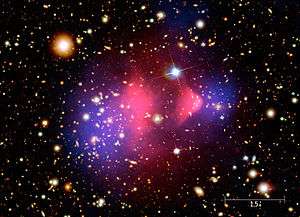Scalar field dark matter
In astrophysics and cosmology scalar field dark matter is a classical, minimally coupled, scalar field postulated to account for the inferred dark matter.[2]
Background
The universe may be accelerating, fueled perhaps by a cosmological constant or some other field possessing long range ‘repulsive’ effects. A model must predict the correct form for the large scale clustering spectrum,[3] account for cosmic microwave background anisotropies on large and intermediate angular scales, and provide agreement with the luminosity distance relation obtained from observations of high redshift supernovae. The modeled evolution of the universe includes a large amount of unknown matter and energy in order to agree with such observations. This energy density has two components: cold dark matter and dark energy. Each contributes to the theory of the origination of galaxies and the expansion of the universe. The universe must have a critical density, a density not explained by baryonic matter (ordinary matter) alone.
Scalar field
The dark matter can be modeled as a scalar field using two fitted parameters, mass and self-interaction.[4][5] In this picture the dark matter consists of an ultralight particle with a mass of ~10−22 eV when there is no self-interaction.[6][7][8] If there is a self-interaction a wider mass range is allowed.[9] The uncertainty in position of a particle is larger than its Compton wavelength (a particle with mass 10−22 eV has a Compton wavelength of 1.3 light years), and for some reasonable estimates of particle mass and density of dark matter there is no point talking about the individual particles’ positions and momenta. Ultra-light dark matter would be more like a wave than a particle, and the galactic halos are giant systems of condensed bose liquid, possibly superfluid. The dark matter can be described as a Bose–Einstein condensate of the ultralight quanta of the field[10] and as boson stars.[9] The enormous Compton wavelength of these particles prevents structure formation on small, subgalactic scales, which is a major problem in traditional cold dark matter models. The collapse of initial over-densities is studied in the references.[11][12][13][14]
This dark matter model is also known as BEC dark matter or wave dark matter. Fuzzy dark matter and ultra-light axion are examples of scalar field dark matter.
See also
- Weakly interacting massive particles – Hypothetical particles that are thought to constitute dark matter
- Minimal Supersymmetric Standard Model
- Neutralino – Neutral mass eigenstate formed from superpartners of gauge and Higgs bosons
- Axion
- Dark matter halo – A theoretical component of a galaxy that envelops the galactic disc and extends well beyond the edge of the visible galaxy
- Light dark matter – Dark matter weakly interacting massive particles candidates with masses less than 1 GeV
- Hot dark matter – A theoretical form of dark matter which consists of particles that travel with ultrarelativistic velocities
- Warm dark matter – A hypothesized form of dark matter that has properties intermediate between those of hot dark matter and cold dark matter
- Fuzzy cold dark matter – A hypothetical form of cold dark matter proposed to solve the cuspy halo problem
References
- Jeremiah P. Ostriker and Paul Steinhardt New Light on Dark Matter
- J. Val Blain, ed. (2005). Trends in Dark Matter Research. Contributors: Reginald T. Cahill, F. Siddhartha Guzman, N. Hiotelis, A.A. Kirillov, V.E. Kuzmichev, V.V. Kuzmichev, A. Miyazaki, Yu. A. Shchekinov, L. Arturo Urena-Lopez, E.I. Vorobyov. Nova Publishers. p. 40. ISBN 978-1-59454-248-0.
- Galaxies are not scattered about the universe in a random way, but rather form an intricate network of filaments, sheets, and clusters. How these large-scale structures formed is at the root of many key questions in cosmology.
- Baldeschi, M. R.; Gelmini, G. B.; Ruffini, R. (10 March 1983). "On massive fermions and bosons in galactic halos". Physics Letters B. 122 (3): 221–224. Bibcode:1983PhLB..122..221B. doi:10.1016/0370-2693(83)90688-3.
- Membrado, M.; Pacheco, A. F.; Sañudo, J. (1 April 1989). "Hartree solutions for the self-Yukawian boson sphere". Physical Review A. 39 (8): 4207–4211. Bibcode:1989PhRvA..39.4207M. doi:10.1103/PhysRevA.39.4207. PMID 9901751.
- Matos, Tonatiuh; Ureña-López, L. Arturo (2000). "Quintessence and scalar dark matter in the Universe". Letter to the Editor. Classical and Quantum Gravity. 17 (13): L75. arXiv:astro-ph/0004332. Bibcode:2000CQGra..17L..75M. doi:10.1088/0264-9381/17/13/101.
- Matos, Tonatiuh; Ureña-López, L. Arturo (2001). "Further analysis of a cosmological model with quintessence and scalar dark matter". Physical Review D. 63 (6): 063506. arXiv:astro-ph/0006024. Bibcode:2001PhRvD..63f3506M. doi:10.1103/PhysRevD.63.063506.
- Sahni, Varun; Wang, Limin (2000). "New cosmological model of quintessence and dark matter". Physical Review D. 62 (10): 103517. arXiv:astro-ph/9910097. Bibcode:2000PhRvD..62j3517S. doi:10.1103/PhysRevD.62.103517.
- Lee, Jae-Weon; Koh, In-Gyu (1996). "Galactic halos as boson stars". Physical Review D. 53 (4): 2236–2239. arXiv:hep-ph/9507385. Bibcode:1996PhRvD..53.2236L. doi:10.1103/PhysRevD.53.2236. PMID 10020213.
- Sin, Sang-Jin; Urena-Lopez, L.A. (1994). "Late-time phase transition and the galactic halo as a Bose liquid". Physical Review D. 50 (6): 3650–3654. arXiv:hep-ph/9205208. Bibcode:1994PhRvD..50.3650S. doi:10.1103/PhysRevD.50.3650. PMID 10018007.
- Alcubierre, Miguel; Guzmán, F. Siddhartha; Matos, Tonatiuh; Núñez, Darío; Ureña-López, L. Arturo; Wiederhold, Petra (2002). "Galactic collapse of scalar field dark matter". Classical and Quantum Gravity. 19 (19): 5017–5024. arXiv:gr-qc/0110102. Bibcode:2002CQGra..19.5017A. doi:10.1088/0264-9381/19/19/314.
- Guzmán, F. Siddhartha; Ureña-López, L. Arturo (2004). "Evolution of the Schrödinger-Newton system for a self-gravitating scalar field". Physical Review D. 69 (12): 124033. arXiv:gr-qc/0404014. Bibcode:2004PhRvD..69l4033G. doi:10.1103/PhysRevD.69.124033.
- Guzmán, F. Siddhartha; Ureña-López, L. Arturo (2006). "Gravitational Cooling of Self-gravitating Bose Condensates". The Astrophysical Journal. 645 (2): 814–819. arXiv:astro-ph/0603613. Bibcode:2006ApJ...645..814G. doi:10.1086/504508.
- Bernal, Argelia; Guzmán, F. Siddhartha (2006). "Scalar field dark matter: Nonspherical collapse and late-time behavior". Physical Review D. 74 (6): 063504. arXiv:astro-ph/0608523. Bibcode:2006PhRvD..74f3504B. doi:10.1103/PhysRevD.74.063504.
